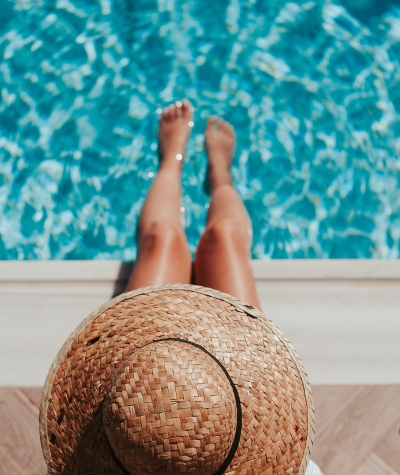Here we look at products to use on the skin. Self-tanning tablets, nasal sprays and injections are not cosmetic products.
If the sunless tanner does not provide any UV protection (which will be indicated by an SPF number and the UVA logo) then it is important to also apply a sun protection product before going out in the sun. Applying self tan does not mean that your skin is protected from further sun exposure.
How do self-tanning products work?
Also known as "sunless tanning", and "fake tan", most self-tanning products contain the active ingredient DHA (dihydroxyacetone), which creates a 'healthy glow' by chemically reacting with the amino acids in the dead layer (the stratum corneum) of the skin's surface. This reaction is non-toxic and skin-safe, it requires no UV exposure and involves no permanent pigmentation.
Some "sunless tanners" contain erythrulose as the active ingredient. This works in the same way as DHA, but the colour it produces develops more slowly. Some products use both DHA and erythrulose, which may produce a longer-lasting effect. The effect of all self-tanning products is temporary and, depending on the individual product, can last up to 10 days.
Why use a self-tanning product?
Sunless tanners are a safe and harmless way of achieving the colour of a tan. Unlike sun-bathing and sun-beds, "self-tan" involves no exposure to UV light, the harmful radiation which can cause skin cancer.
UV (ultra violet) light is made up of UVA, UVB and UVC rays. UVB penetrates the skin and is absorbed by the cells, causing the skin to become inflamed and red (sunburn). UVA penetrates deeper and causes direct damage to supporting tissues, making the skin age. Both are linked to causing skin cancer. UVC rays are absorbed by the Earth's atmosphere and do not normally reach us at ground level.
Most "self-tan" products contain moisturising ingredients which keep the skin healthy and supple. They do not cause the skin to age, or to become inflamed and red as they do not involve exposure to UV rays. However, not all sunless tanning products contain UV filters, and so they do not provide any sun protection. If the sunless tanner is also a sunscreen, it will have an "SPF" (sun protection factor) and UV protection rating on the label.
Is it safe to use self-tanning lotions during pregnancy or when breastfeeding?
Yes, self-tanning products are safe to use during pregnancy and whilst breastfeeding although you probably wouldn't want to apply it to your breasts because it won't taste or smell very nice for your baby and you wouldn't want them to swallow it. Some mothers worry about the effect of cosmetics on their breast milk. There is no evidence to suggest that cosmetics make breast milk unsafe.
New innovations
Self-tanning moisturisers
There are many moisturisers with added "self-tanners" available. These have the same effect as a moisturiser but simultaneously build a gradual and temporary 'tan' on application. Such products contain the same tanning ingredient as "sunless tanners", i.e. DHA or erythrulose; however, this is diluted with moisturising agents, so the products usually need to be applied regularly for the colour to build up over time.
Sunscreens with added "self-tan"
These products protect the skin from harmful UV rays, using UV filters, as any normal sunscreen does. The difference is that they simultaneously create a glow, regardless of sunlight, because they contain either DHA or erythrulose.


